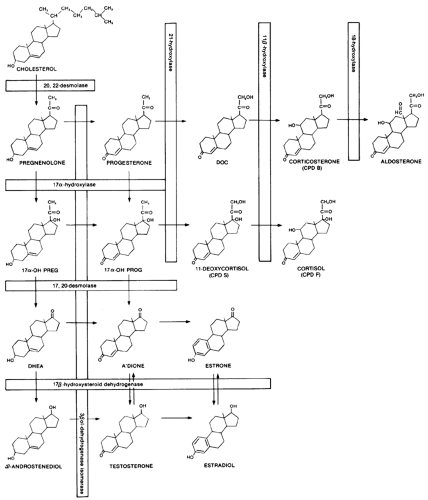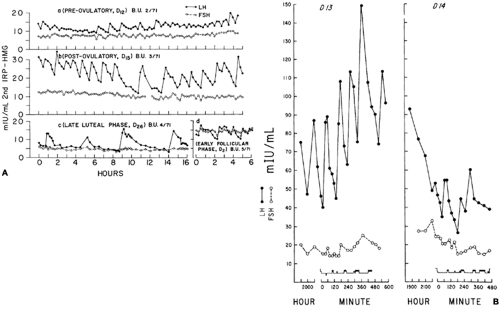HORMONAL CHANGES DURING THE NORMAL MENSTRUAL CYCLE
Circulating concentrations of FSH begin to increase in the late luteal phase of the previous menstrual cycle14,15 and 16 (see Fig. 95-2). The increase in FSH levels continues into the early follicular phase and is responsible for initiating the growth and development of a group of follicles. The oocyte that will be ovulated is selected from this cohort undergoing development, but the manner of selection is not understood. FSH levels then fall after the early follicular phase increase. Except for a brief peak at midcycle, FSH levels continue to fall until they reach their lowest levels in the midluteal phase, just before they begin to increase again before menses.
Circulating LH concentrations also begin to increase in the late luteal phase of the previous menstrual period.14,15 and 16 However, in contrast to FSH levels, LH concentrations continue to increase gradually throughout the follicular phase. At midcycle, there is a significant increase in circulating LH levels that lasts 1 to 3 days and triggers ovulation. Currently available urinary LH-testing kits detect the LH surge with reasonable accuracy. LH levels gradually decrease in the luteal phase to
reach their lowest levels just before beginning to increase again before menses.
reach their lowest levels just before beginning to increase again before menses.
As is true for virtually all hormones, the gonadotropins (especially LH) are secreted in a pulsatile manner, with intervals of 1 to 4 hours between pulses, depending on the phase of the menstrual cycle.17,18 and 19 (Fig. 95-3). LH pulse frequency is lowest during the luteal phase of the menstrual cycle, apparently because of the effects of progesterone.20 The pulsatile secretion of the gonadotropins is dependent on the pulsatile secretion of GnRH by the hypothalamus.21
The ovary secretes numerous steroidal and nonsteroidal hormones. Several of the steroids secreted by the ovary also are secreted by the adrenal gland, and some are formed by peripheral conversion from other steroid precursors (Fig. 95-4). Consequently, circulating concentrations do not reflect ovarian production rates. Several steroids secreted by the ovary do vary throughout the menstrual cycle (Fig. 95-5, see Chap. 94).
 FIGURE 95-4. Pathways of steroidogenesis. The necessary enzymes are depicted as well as the steroids.
Stay updated, free articles. Join our Telegram channel
Full access? Get Clinical Tree
 Get Clinical Tree app for offline access
Get Clinical Tree app for offline access

|



